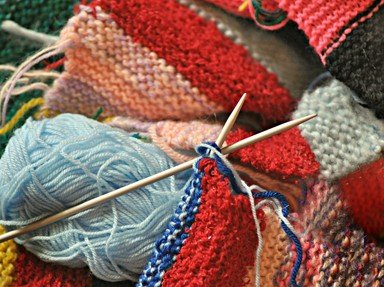Quiz Answer Key and Fun Facts
1. All ready for my new project, I knit a small square called (where I live) a gauge sample, and counted how many stitches and rows there were in a 5cm square. Whoops! I only had 12 stitches, and the pattern said I should have 15. What on earth should I do to fix this problem?
2. The pattern I was following said I should work 10 cm of k1, p1 ribbing, to produce the stretchy effect of the illustrated material. I duly cast on 121 stitches, as required for my size, and worked a couple of rows, starting with a knit stitch on each row. Horrors! It didn't look at all right, but had an uneven bumpy look. What went wrong?
3. Finished the ribbing, I started in on the stockinette stitch that was to form the next part of my project. I expected to see a smooth surface, like that of your standard sweater/jumper, but was appalled when I spread it out after a number of rows to see that it was all bumpy, like the picture. So where did I go wrong?
4. So there I was, knitting away with my lovely handspun llama yarn, when all of a sudden I found I had used up the entire ball! Since I was in the middle of a row, how did my knitting guide advise me to address this problem?
5. There I was, knitting away, and things seemed to be going swimmingly. Then I spread it out to admire my handiwork, and I saw a big hole in the middle of my work! Which of these might I have accidentally done to produce this?
6. I dug up a fairly old pattern, passed down from my grandmother, for a pair of socks, and it recommended using double-pointed needles. Since I didn't have any of them, I decided to just adapt the instructions and use regular knitting needles. Why did I discover that this was a poor idea?
7. Crumbs, I was supposed to be increasing at each end of the row on every twentieth row, but for the life of me I couldn't remember how many rows I had worked since the last increase. What handy device should I have employed to avoid this?
8. I knew I should never have tried something as tricky as this cable pattern! I was sure I had followed all the complex instructions, but when I held it up to compare with the picture, I found that the pieces in the middle appeared to cross right over left, instead of left over right. What had I done wrong this time?
9. This project might have been a bit ambitious for me, I guess. I could have sworn I followed all the instructions, but when I was finished I found there were all of these little gaps around the colored patches. Is there a quick way to fix this?
10. The beanie was going fine until I got to the mystifying instruction that I had to decrease a stitch in every eight on the next row. I couldn't decide whether I should use k2tog or slip-k-psso in order to decrease the necessary stitches. Panic! Which should I have chosen?
Source: Author
looney_tunes
This quiz was reviewed by FunTrivia editor
ozzz2002 before going online.
Any errors found in FunTrivia content are routinely corrected through our feedback system.


